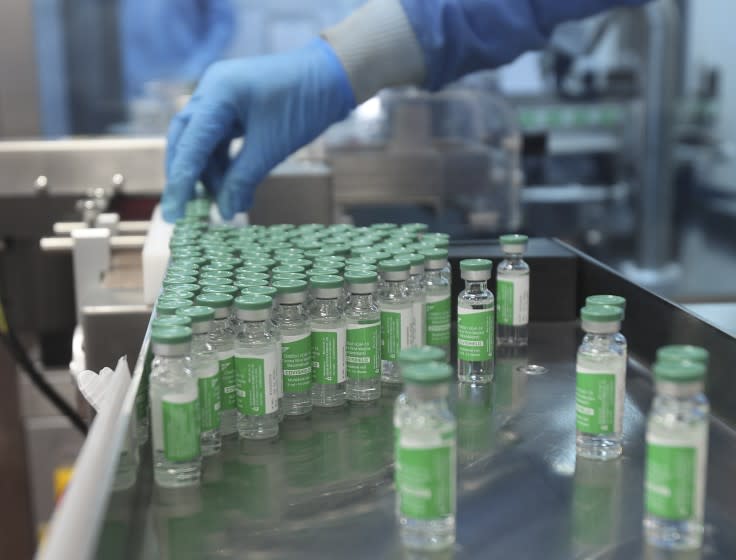Op-Ed: Vaccine hoarding by wealthy nations will only prolong the pandemic

Samantha Power, President Biden’s new administrator of the U.S. Agency for International Development, recently talked to the New York Times about how America helps vaccinate the rest of the world against COVID-19. “It’s about a very, very tangible, results-oriented agenda,” she said.
At the Group of 7 summit, Biden announced that the U.S. would contribute 500 million vaccine doses for use in “low- and middle-income countries.” Some said this promise caused other countries to step up their contributions to a billion doses by 2022.
Yet, the actual new commitment, according to the World Health Organization, was for 870 million additional doses, not a billion, “with the aim to deliver at least half by the end of 2021.”
In other words, the aim would be to get 435 million doses to the COVAX facility (the international mechanism established to ensure vaccine access in poorer countries) by 2022. Even if all billion come in over the course of 2022, Agnès Callamard, the secretary-general of Amnesty International, has called it a “drop in the ocean,” made of “paltry half-measures and insufficient gestures.” Gavin Yamey of Duke University, summing up the current situation, said, “Rich countries behaved worse than anyone’s worst nightmares.”
And there is a further problem: The G-7 commitments are only promises, and the G-7’s track record on meeting its promises is not especially good.
Today, Africa and India have vaccinated barely 3% of their combined populations of about 2.5 billion people. Why is that? The U.S. alone is reputed to have the capacity to produce 4.7 billion doses by the end of 2021 — 4 billion more than America needs. Again, according to Amnesty International, the G-7 will have 3 billion surplus doses by the end this year.
Where are those doses going? Apparently to wealthy customers. This includes 1.8 billion doses committed to the European Union for booster shots, as reported by Varsha Gandikota-Nellutla of Progressive International. Meanwhile, outside the rich-country bubble, the virus can spread, sicken and kill.
This is not merely a humanitarian issue. If viruses are not eradicated, they evolve. Already, multiple variants of the coronavirus have appeared. As far as we know, none can overcome the available vaccines. But no one can say for sure that such a variant will not emerge, and the more time lost, the greater the risk — and not merely for the world’s poor.
One obvious solution is to get the hoarded vaccine stockpile into arms all around the world. A second would be to waive patent protection and supply restrictions on the Western vaccines, so that they can be produced more rapidly in other countries.
If India, the world’s largest vaccine producer, could overcome current production difficulties, it could resume exports and start supplying doses to the rest of Asia and to Africa, while meeting its own requirements by the end of this year. Enough doses could be produced to end the pandemic, for practical purposes, by the end of 2022.
In early May, the Biden administration announced its support for a proposal, advanced by India and South Africa, to waive Trade-Related Aspects of Intellectual Property Rights (TRIPS) enforcement on COVID-19 supplies, including vaccines. But what does this amount to? So far, just support for negotiations.
It was government, not the big drug companies, that underwrote the basic research used to invent these vaccines. The companies have patents only because they were granted as an “incentive” to produce them. The claim that otherwise they would not do so is absurd: The U.S. government has the power of compulsion under the Defense Production Act, which it has already used to get vaccine production ramped up.
Meanwhile, China is currently vaccinating more than 10 million people per day — an accelerating pace that will cover their entire population this year. In 2022, China could produce up to 5 billion doses for the world — enough for India and Africa combined. Meanwhile, Chinese producers are determined to build production sites worldwide, beginning recently in Egypt. And Russia has plans to produce more than 850 million doses of Sputnik V in India alone this year. That’s just about the same as the entire G-7 commitment – and it will happen sooner.
Not every projection will work out. And it may be true, as reported, that the Chinese vaccines are less effective than those produced by Pfizer-BioNTech, Moderna, AstraZeneca, Johnson & Johnson and Sputnik V.
But for now, the U.S. and Europe are offering crumbs. Meanwhile, China and Russia have other ideas and the capacity to realize them. So, before too long, when the back of this pandemic is finally broken, the world will have fresh evidence about who is reliable and who is not.
I would say that all of this is unprecedented, but it’s not. In the cold and hungry European winter of 1947-48, Jan Masaryk, the Czechoslovak foreign minister, pleaded with the U.S. for food shipments. The U.S. dithered, imposing conditions. Klement Gottwald, head of the Czechoslovak Communist Party, appealed to Joseph Stalin, who put 300,000 tons of wheat onto trains. Czechoslovakia fell under full Communist control in February 1948.
It is all about tangible results.
James K. Galbraith holds the Lloyd M. Bentsen Jr. Chair in Government/Business Relations at the LBJ School of Public Affairs at the University of Texas at Austin.
This story originally appeared in Los Angeles Times.

